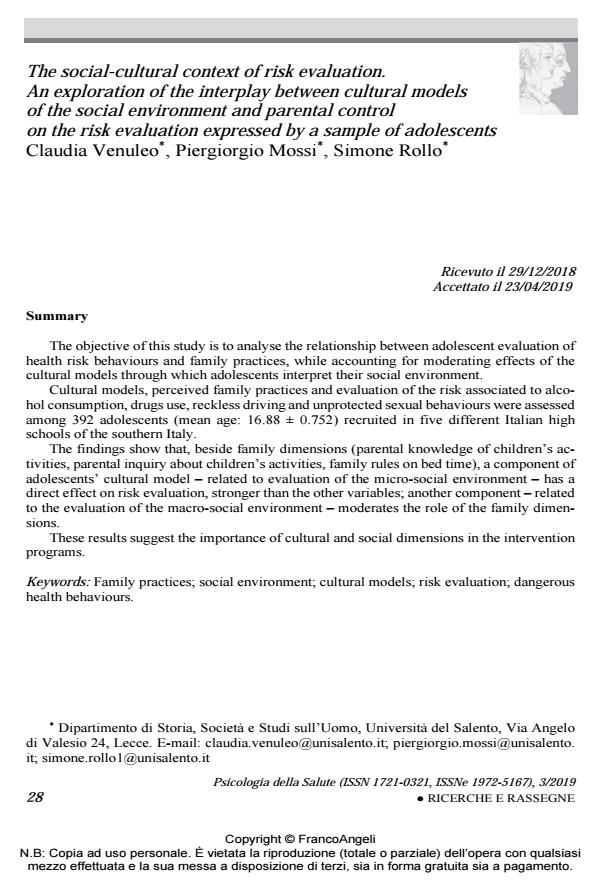The social-cultural context of risk evaluation. An exploration of the interplay between cultural models of the social environment and parental control on the risk evaluation expressed by a sample of adolescents
Titolo Rivista PSICOLOGIA DELLA SALUTE
Autori/Curatori Claudia Venuleo, Piergiorgio Mossi, Simone Rollo
Anno di pubblicazione 2019 Fascicolo 2019/3
Lingua Inglese Numero pagine 26 P. 28-53 Dimensione file 297 KB
DOI 10.3280/PDS2019-003003
Il DOI è il codice a barre della proprietà intellettuale: per saperne di più
clicca qui
Qui sotto puoi vedere in anteprima la prima pagina di questo articolo.
Se questo articolo ti interessa, lo puoi acquistare (e scaricare in formato pdf) seguendo le facili indicazioni per acquistare il download credit. Acquista Download Credits per scaricare questo Articolo in formato PDF

FrancoAngeli è membro della Publishers International Linking Association, Inc (PILA)associazione indipendente e non profit per facilitare (attraverso i servizi tecnologici implementati da CrossRef.org) l’accesso degli studiosi ai contenuti digitali nelle pubblicazioni professionali e scientifiche
The objective of this study is to analyse the relationship between adolescent evaluation of health risk behaviours and family practices, while accounting for moderating effects of the cul-tural models through which adolescents interpret their social environment. Cultural models, perceived family practices and evaluation of the risk associated to alcohol consumption, drugs use, reckless driving and unprotected sexual behaviours were assessed among 392 adolescents (mean age: 16.88 ± 0.752) recruited in five different Italian high schools of the southern Italy. The findings show that, beside family dimensions (parental knowledge of children’s activities, parental inquiry about children’s activities, family rules on bed time), a component of adolescents’ cultural model - related to evaluation of the micro-social environment - has a direct effect on risk evaluation, stronger than the other variables; another component - related to the evaluation of the macro-social environment - moderates the role of the family dimensions. These results suggest the importance of cultural and social dimensions in the intervention programs.
Lo studio si propone di analizzare la relazione tra la valutazione dei comportamenti a ri-schio per la salute tra gli adolescenti e le pratiche genitoriali tenendo conto degli effetti di mo-derazione dei modelli culturali con cui gli adolescenti interpretano il loro ambiente sociale. In un campione di 392 adolescenti (età media: 16.88 ± 0.752), reclutati in cinque differenti istituti scolastici del Sud Italia, sono stati misurati i modelli culturali, le pratiche genitoriali per-cepite e la valutazione del rischio rispetto ad assunzione di alcol, uso di droghe, guida sperico-lata e comportamenti sessuali non protetti. I risultati mostrano che, oltre alle dimensioni familiari (conoscenza genitoriale delle attività dei figli, supervisione parentale sulle attività dei figli, regole famigliari sul tempo libero), una componente del modello culturale degli adolescenti - la valutazione dell’ambiente micro-sociale - ha un effetto diretto sulla valutazione del rischio, maggiore rispetto alle altre variabili; un’altra componente dei modelli culturali degli adolescenti la valutazione dell’ambiente ma-cro-sociale ha un effetto di moderazione rispetto al ruolo delle dimensioni familiari. I risultati suggeriscono l’importanza delle dimensioni culturali e sociali nella progettazione di interventi sui comportamenti a rischio.
Parole chiave:Pratiche familiari; ambiente sociale; modelli culturali; valutazione del rischio; comportamenti dannosi per la salute.
- What Adolescents Have to Say about Problematic Internet Use: A Qualitative Study Based on Focus Groups Simone Rollo, Claudia Venuleo, Lucrezia Ferrante, Raffaele De Luca Picione, in International Journal of Environmental Research and Public Health /2023 pp.7013
DOI: 10.3390/ijerph20217013 - The Meaning of Living in the Time of COVID-19. A Large Sample Narrative Inquiry Claudia Venuleo, Tiziana Marinaci, Alessandro Gennaro, Arianna Palmieri, in Frontiers in Psychology 577077/2020
DOI: 10.3389/fpsyg.2020.577077 - Effect of the Social and Cultural Control on Young Eastern Ethnic Minority Groups’ Online-Startup Motivation Lifu Li, Kyeong Kang, in Entrepreneurship Research Journal /2024 pp.491
DOI: 10.1515/erj-2021-0262 - “What Game are We Playing?”: the Psychosocial Context of Problem Gambling and Gaming Among Italian High School Students Tiziana Marinaci, Claudia Venuleo, Lucrezia Ferrante, Salvatore Della Bona, in SSRN Electronic Journal /2021
DOI: 10.2139/ssrn.3870262 - What game we are playing: the psychosocial context of problem gambling, problem gaming and poor well-being among Italian high school students Tiziana Marinaci, Claudia Venuleo, Lucrezia Ferrante, Salvatore Della Bona, in Heliyon e07872/2021 pp.e07872
DOI: 10.1016/j.heliyon.2021.e07872 - A che gioco stiamo giocando? Uno studio sulle determinanti psicosociali del consumo di gioco problematico e del malessere tra gli adolescenti Claudia Vanuleo, Salvatore Della Bona, Tiziana Marinaci, in MISSION 62/2024 pp.43
DOI: 10.3280/mis62-2023oa17023 - Stability of Worldviews and Their Organizing Structures Over Time: A Retrospective Analysis Matteo Reho, Alessandro Gennaro, Skaiste Kerušauskaitė, Gordon Sammut, Sergio Salvatore, in Culture & Psychology 1354067X251389919/2025
DOI: 10.1177/1354067X251389919 - Youths’ Wellbeing Between Future and Uncertainty Across Cultural Contexts: A Focus on Latent Meanings as Mediational Factors Massimo Ingrassia, Narine Khachatryan, Simone Rollo, Edita Arakelyan, Tsaghik Mikayelyan, Loredana Benedetto, in European Journal of Investigation in Health, Psychology and Education /2025 pp.244
DOI: 10.3390/ejihpe15120244
Claudia Venuleo, Piergiorgio Mossi, Simone Rollo, The social-cultural context of risk evaluation. An exploration of the interplay between cultural models of the social environment and parental control on the risk evaluation expressed by a sample of adolescents in "PSICOLOGIA DELLA SALUTE" 3/2019, pp 28-53, DOI: 10.3280/PDS2019-003003